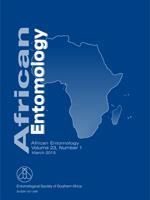False codling moth, Thaumatotibia leucotreta (Meyrick) (Lepidoptera: Tortricidae), is indigenous to sub-Saharan Africa and infests a large number of commercial and wild fruit-bearing plants. The pest was unknown in theWestern Cape Province of South Africa until the end of the 1960s, when it was first identified in fruit orchards in the Paarl region. By the late 1970s T. leucotreta was well established on citrus and other host plants in the Olifants River Valley, approximately 180 km north of Paarl. Since then, control measures for the pest included a small number of insecticides, mating disruption and orchard sanitation. However, a longer termsolution was needed and research on the sterile insect technique was initiated in 2002. This initially involved three phases: a study of the radiation biology and F1 sterility of T. leucotreta (phase 1), field cage experiments (phase 2) and a pilot project over 35 ha of T. leucotreta-susceptible citrus (phase 3). Favourable results in these studies led to the design and construction of T. leucotreta-specific rearing equipment and the building of a massrearing facility capable of producing up to 21 million insects per week (phase 4). Commercial sterile insect releases over 1500 ha of citrus orchards in the Citrusdal region commenced in 2007–08. This area was expanded to 3000 ha in 2008–09 and 4000 hectares in 2009–10 (phase 5). Over the three years the status of T. leucotreta as a pest threat was systematically reduced in the sterile insect release area compared to the non-release area. Feral male populations were reduced 3-, 8- and 10-fold, pre-harvest crop losses decreased by 50 %, 80%and 93 %, and post-harvest export fruit rejections in the SIT area dropped 13 %, 25 % and 38 %, respectively, compared to the non-SIT area.
How to translate text using browser tools
1 March 2015
Development of the Sterile Insect Technique to Suppress False Codling Moth Thaumatotibia leucotreta (Lepidoptera: Tortricidae) in Citrus Fruit: Research to Implementation (Part 1)
J.H. Hofmeyr,
J.E. Carpenter,
S. Bloem,
J.P. Slabbert,
M. Hofmeyr,
S.S. Groenewald
ACCESS THE FULL ARTICLE
It is not available for individual sale.
This article is only available to subscribers.
It is not available for individual sale.
It is not available for individual sale.

African Entomology
Vol. 23 • No. 1
March 2015
Vol. 23 • No. 1
March 2015
commercialization
false codling moth
ionizing radiation
mass-rearing
sterile insect technique




